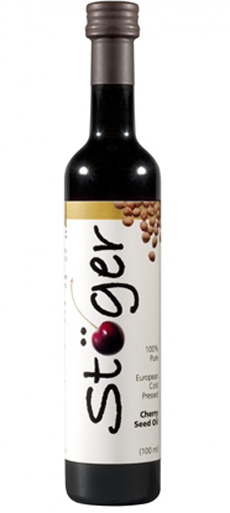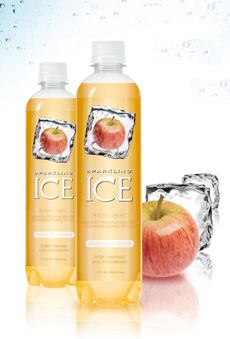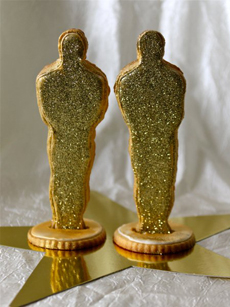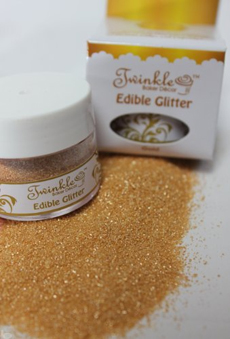|
It’s both easy and hard to describe Malaysian food. It’s a culinary adventure: a blend of Chinese, Indian and native Malay cuisines, sprinkled with Middle Eastern, Portuguese and Southeast Asian influences including Thailand, its neighbor to the north.
The cuisine represents the peoples who populate Malaysia, and those traders who passed through, dating back to the 15th century and earlier.
It’s an exciting cuisine: Whatever recipe you cook (or order), it’s delicious. The seasonings that make the meats, noodles, seafood and vegetables taste so special include banana leaf, bean sprouts, belacan (dried shrimp paste), coconut cream and coconut milk, curry leaf, galangal, kaffir lime leaf, laksa leaf,* lemongrass, tamarind and sesame oil. Spices include cardamom, clove, coriander, cumin, fenugreek, shallot, star anise and turmeric.
|
|

The two parts of Malaysia—peninsula and island—are highlighted in green. Map courtesy Wikimedia. |
|
Unfortunately, there’s far too little Malaysian cuisine in the U.S. Chinese, Japanese, Thai and Vietnamese restaurants are represented in most big cities, but Malaysian eateries remain a trend waiting to happen. Perhaps that’s because most of us couldn’t pinpoint Malaysia on a map. So here it is in the map above: the two land masses highlighted in green.
Malaysia is a constitutional monarchy in the middle of Southeast Asia, separated by the South China Sea into two regions, Peninsular Malaysia and East Malaysia (Malaysian Borneo). Peninsular Malaysia is immediately south of Thailand; the island shares borders with Indonesia and Brunei. The major cities and most of the population are on the peninsula, including the capital city, Kuala Lumpur, Malacca and Penang.
India lies west, across the Bay of Bengal. Malacca, a port on the west coast, was the center of the 16th century spice trade, attracting British, Dutch and Portuguese traders.
*Laksa is a fragrant herb with an intense lemony flavor and hints of eucalpytus, used in Malaysian stews.
THE DELIGHTS OF MALAYSIAN CUISINE
Highlights of Malaysian cuisine include rice- and noodle-based dishes, curries and stews, and Indian-style breads. The “national dish” is nasi lemak: a rice dish steamed with coconut milk and local herbs (ginger, lemongrass and pandus leaf) and served with with fried anchovies, peanuts, sliced cucumber, hard-cooked eggs and sambal, a spicy chile paste. A curry or a spicy meat stew (rendang—see photo below) can be added for a more substantial meal.
|
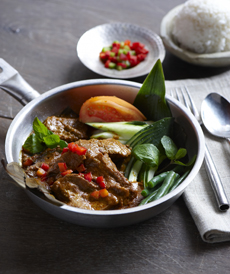
Beef rendang, one of Malaysia’s most popular
dishes. Photo courtesy Tourism Malaysia. |
|
But why talk about the food, when the Malaysian government has done such a good job of promoting it with photos and recipes?
MalaysiaKitchenNYC.com is a lovely website that explains the cuisine while providing lots of recipes. This week the home page features an exotic dish, ais kacang or air batu campur (literally, “red bean ice”).
It’s a dessert: a brightly-colored dish made with different flavored syrups, jellies and dressings on a base of cubes of agar agar and cendol, grass jelly, palm seed, red beans, sweet corn, form the base. It’s a popular treat at Malaysian coffee shops and food courts.
But don’t be spooked by the unfamiliar: Make the featured recipe of the week, beef short ribs rendang.
|
If you have access to an international food market, you may be able to find all the ingredients you need to create a memorable Malaysian dinner. You can also get like-minded friends in on the action, and have everyone prepare a different dish.
FIND A MALAYSIAN RESTAURANT
There is a scattering of Malaysian restaurants in California, Connecticut, New Jersey and New York City: Use this Malaysian restaurant locator to find the ones nearest to you.
CULINARY TRAVEL
Tourism Malaysia has developed culinary tours to highlight this beautiful country and its cuisine. Check with your travel agent or the two Tourism Malaysia offices in Los Angeles and New York City: TourismMalaysia.com.
|
|
